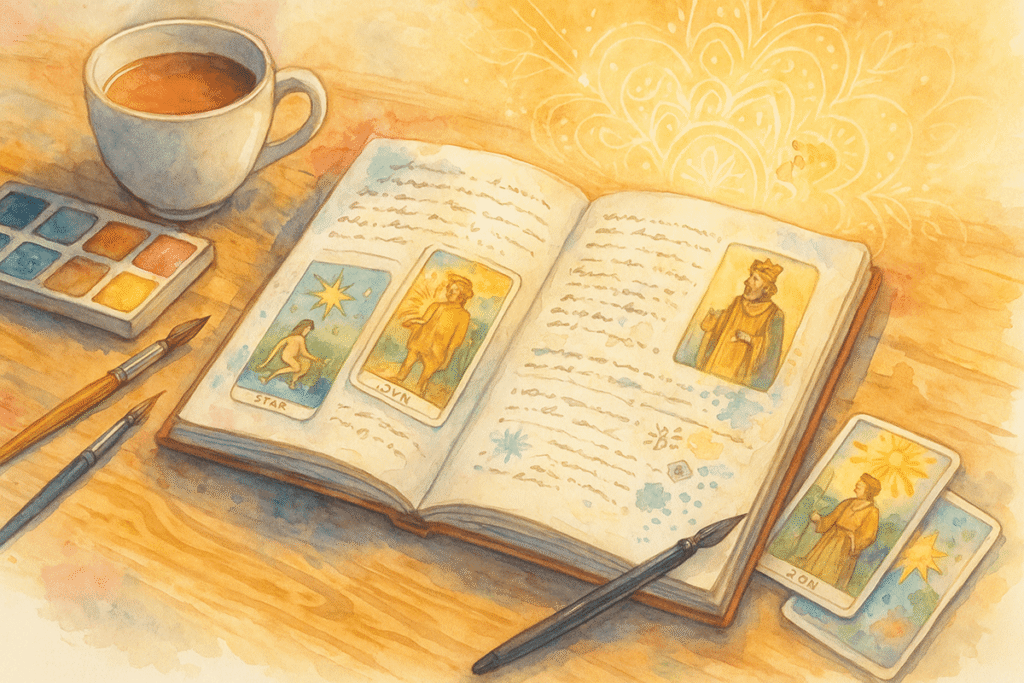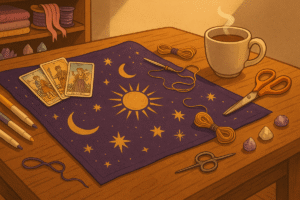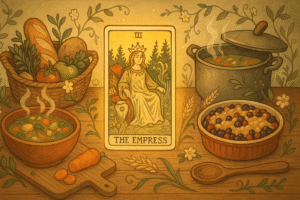Table of Contents
There’s something magical about sitting with a deck of cards and a blank journal page. I’ve noticed that when these two practices come together, they create a space for deeper self-reflection that neither could achieve alone. Perhaps it’s the way the visual symbols of tarot spark thoughts that might otherwise remain buried, or how the act of writing helps us process the emotions that certain cards bring up.
Combining tarot and journaling isn’t just about recording card meanings or tracking daily draws. It’s about creating a dialogue between your conscious mind and the deeper currents of your inner world. The cards become conversation starters, and your journal becomes the space where that conversation unfolds.
Why Tarot and Journaling Work So Well Together
When I first started exploring this combination, I was surprised by how much more I got from each practice. Tarot alone can sometimes feel abstract or overwhelming, especially when a card’s imagery speaks to you but you can’t quite put your finger on why. Journaling alone, while therapeutic, sometimes leaves us staring at a blank page, unsure where to begin.
Together, they solve each other’s challenges. Tarot provides the prompt that journaling often lacks, while journaling gives structure to the insights that tarot can spark. The cards offer a visual anchor for your thoughts, and writing helps you explore what those images mean to you personally.
The process becomes less about “getting the right answer” from the cards and more about discovering what questions you need to ask yourself. I think that’s where the real value lies.
Creating a Foundation for Your Practice
Before diving into specific techniques, it helps to set up a space that supports both activities. You don’t need anything fancy, but having a dedicated journal for this work can make the experience feel more intentional. Some people prefer lined journals for structured writing, while others find blank pages better for combining text with sketches or card layouts.
Your writing tools matter too, though perhaps not in the way you’d expect. I’ve found that using a pen rather than pencil makes the process feel more committed somehow. There’s something about the permanence that encourages honesty, even when what you’re writing feels uncertain or contradictory.
The timing of your practice can shift based on what you’re hoping to explore. Morning sessions might focus on setting intentions or processing dreams, while evening work could help you reflect on the day’s experiences. There’s no perfect time, really, just the time that feels right for you.
The Daily Draw Dialogue Technique
One of the most accessible ways to combine these practices starts with a simple daily card draw. But instead of just reading the traditional meaning, try having a written conversation with the card. Pull your daily card, then write something like “Good morning, Five of Cups. What do you want me to notice today?”
Then let yourself respond as if you were the card. This might feel awkward at first, I know it did for me, but something interesting happens when you give voice to the card’s perspective. You might write back: “I’m here to remind you that grief and disappointment are part of growth. Notice what you’re still mourning from last week.”
The conversation can continue from there. Ask follow-up questions, challenge what the card seems to be suggesting, or explore why certain aspects of its imagery catch your attention. The goal isn’t to get “the right interpretation” but to use the card as a starting point for self-discovery.
Storytelling Through Spreads
Perhaps my favorite technique involves treating tarot spreads as story prompts. Draw three cards and write a short story that weaves them together. The characters, plot, and setting are entirely up to you, but they should somehow incorporate the essence of each card.
This approach works particularly well with court cards, which naturally suggest different personality types or roles. The Queen of Wands, Knight of Swords, and Four of Pentacles might become characters in a story about ambition, impulsiveness, and security. As you write, you might notice which character you identify with most, or which aspects of the story feel most relevant to your current situation.
Sometimes the stories that emerge surprise me. A spread that initially seemed to be about work relationships might transform into a tale about family dynamics, revealing connections I hadn’t consciously recognized. The act of creative writing seems to bypass our analytical mind and tap into deeper patterns of meaning.
Visual Journaling with Card Imagery
Not all journaling has to be written. Tarot cards are rich with visual symbols that can inspire artistic exploration, even if you don’t consider yourself particularly artistic. Choose a card that resonates with you and spend some time sketching elements from it. This doesn’t have to be perfect or even recognizable to anyone else.
I remember spending an afternoon drawing the towers from various cards, not because I was trying to improve my artistic skills, but because I was curious about what different types of structures meant to me emotionally. The Tower card’s crumbling edifice felt different from the solid castle walls in the Four of Pentacles, and exploring that difference through drawing helped me understand my own relationship with stability and change.
You can also use cards as inspiration for color studies, collages, or even abstract doodles. The key is letting the imagery guide your hand without forcing a specific outcome. Often, what you choose to emphasize or ignore in your artistic interpretation reveals something about your current mindset or concerns.
Working with Challenging Cards
Some of the most valuable journaling sessions come from sitting with cards that make you uncomfortable. When the Ten of Swords or the Devil appears in your daily draw, it’s tempting to shuffle them back into the deck and try again. But these challenging cards often have the most to teach us.
Try writing a letter to a difficult card, expressing your feelings about its appearance in your reading. Be honest about any fear, frustration, or resistance you feel. Then write a response from the card’s perspective, exploring what gifts it might offer despite its harsh exterior.
I’ve found that cards I initially disliked often become some of my most trusted guides once I’ve worked through my resistance to them. The Tower, which once terrified me, now feels like an old friend who’s not afraid to tell me hard truths. That relationship didn’t develop overnight, but through repeated written conversations and honest exploration of my reactions.
The Weekly Reflection Spread
At the end of each week, consider doing a more extensive spread combined with longer-form journaling. Draw five cards representing different aspects of your week: challenges faced, lessons learned, emotions processed, relationships emphasized, and energy for the week ahead.
Write a paragraph or two about each card, not just describing what happened during your week, but exploring the deeper currents underneath. Maybe the Seven of Wands appeared for your challenges, and you can write about not just the specific conflicts you faced, but how you tend to handle opposition in general.
This technique helps you see patterns over time. After several weeks, you might notice that certain cards or themes keep appearing, suggesting areas of your life that want more attention or development.
Making It Your Own
The techniques I’ve shared are starting points, not rigid rules. Your practice will evolve as you discover what works for your personality, lifestyle, and goals. Some people prefer structured prompts, while others like to let their writing flow wherever the cards take them.
Pay attention to what brings you insights and what feels forced or artificial. Maybe you’ll discover that you prefer working with single cards rather than spreads, or that certain types of journaling questions resonate more than others. The practice should feel supportive and illuminating, not like homework.
Remember too that not every session needs to produce profound insights. Sometimes the value is simply in the act of slowing down, paying attention, and giving yourself space for reflection. In our busy world, that alone is a meaningful practice.
Building Long-Term Insights
Over time, your journal becomes a record of your inner journey. Reading entries from months ago can reveal how much you’ve grown or help you recognize recurring themes in your life. Patterns that weren’t visible in individual sessions become clear when viewed from a broader perspective.
Consider dating your entries and occasionally looking back at previous work with the same cards. How has your relationship with the Hermit evolved? What new layers do you see in the Empress now that weren’t visible six months ago? This long-term perspective adds richness to your practice and helps you appreciate your own development.
The combination of tarot and journaling creates a practice that grows with you, offering new depths as your life experiences expand and your self-understanding deepens. It’s a conversation that can continue for years, always revealing new facets of both the cards and yourself.
Frequently Asked Questions
Do I need to know tarot card meanings before I start journaling with them?
Not at all. Starting with a fresh perspective can actually be more valuable because you’ll develop your own personal connection to the cards. Look at the imagery first and write about what you see and feel, then check traditional meanings if you’re curious. Your initial impressions are just as valid as any guidebook definition, and combining both perspectives creates a richer understanding.
How often should I practice tarot journaling?
There’s no right frequency, and it’s important that this doesn’t become a chore. Some people enjoy a daily morning card as a gentle ritual, while others prefer weekly sessions when they have more time for deeper reflection. Listen to what feels sustainable for you. Even once a week can reveal meaningful patterns over time, and it’s perfectly fine to skip sessions when your intuition tells you to take a break.
What type of journal works best for combining tarot and writing?
The best journal is simply one you’ll actually use. A basic spiral notebook from any store works perfectly fine. Some people prefer lined pages for structured writing, while others like blank pages that allow space for sketches or card layout diagrams. If you enjoy getting creative, you might want something sturdy enough to handle collages or drawings, but a simple notebook is genuinely all you need to begin.
Can I use tarot apps instead of physical cards for journaling?
Yes, apps work well for the writing aspects of tarot journaling and offer convenience when you’re traveling or don’t want to carry a deck. However, many people find that physically shuffling and drawing cards adds a tactile, ritualistic quality that deepens the experience. If you’re trying to decide, you might start with an app and see if you eventually feel drawn to invest in a physical deck.







